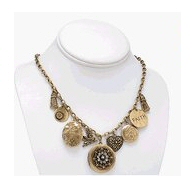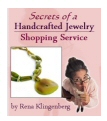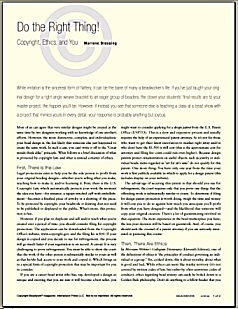AdornmentCraft has moved!
August 15, 2007
Greetings all,
I’ve moved the blog over to its own domain – www.adornmentcraft.com.
Please update your bookmarks and grab the new RSS feeds there.
~Chris
Launch of Beadingdaily.com
August 7, 2007
 Interweave Press recently announced the launch of its new “online community” site, Beading Daily, so I paid it a visit.
Interweave Press recently announced the launch of its new “online community” site, Beading Daily, so I paid it a visit.
It’s a really nice-looking site, full of a lot of free projects and ideas. In order to access the project instructions, you need to register on the site with your email address. This makes you a Beading Daily charter member.
 Unless you opt out of emails, you will also receive a daily email newsletter that contains blog posts on three days of the week. On the other two days, you’ll receive “cool information about Interweave books, magazines, and events that may be of interest to you” (according to the Beading Daily FAQ page).
Unless you opt out of emails, you will also receive a daily email newsletter that contains blog posts on three days of the week. On the other two days, you’ll receive “cool information about Interweave books, magazines, and events that may be of interest to you” (according to the Beading Daily FAQ page).
For now, all the projects are free of charge, but in the future some will be available for purchase. The project library is a combination of tutorials previously published in Interweave magazines and brand-new projects.
I know that a lot of beaders are always looking for new projects to try (especially free ones!), so I suspect that Beading Daily will become a popular site.
If you knit, you may also be interested in Interweave’s similar site, Knitting Daily, which launched earlier this summer.
Las Vegas Strip jewelry trends
August 6, 2007

I just returned from my trip to Las Vegas, and I thought I’d jot down my impressions of the current jewelry trends on The Strip. I found them to be typical of the trends we’ve seen over the past few years in other parts of the country, with just a touch of extra Las Vegas bling.
First, not surprisingly, glitter and sparkles are everywhere. I saw crystal rhinestone jewelry on display in lots of shops, as well as rhinestone-encrusted other-things, like little boxes and handbags. I didn’t, however, notice too many women actually wearing rhinestone jewelry. (One notable exception was a pop singer performing onstage.)
Big, chunky, faceted, translucent faux-gemstones linked into chains were displayed in most of the boutiques. To me, as a jewelry artisan, most of them (even the expensive ones) looked to be lower quality than necessary.

The most common metals were gold and bronze-tone, although I also noticed some interesting copper-tone pieces and a decent amount of silver-tone.
Layered necklaces and multi-strand beaded bracelets were everywhere, as were multiple, eclectic charms and drops.
Earrings were mostly large and bold, and very-large hoops were especially prominent. I noticed them both in the boutiques and being worn by many of the women wandering The Strip.
Most finger rings featured over-sized, faceted jewels – another trend we’ve seen a lot of in past years.
As for other accessories, I’d say that flip-flops (some with rhinestones, of course!) and over-sized, high-end sunglasses were the biggest must-haves.
By the way, The Strip itself has undergone significant changes in recent years, with big, new, clean casinos and lots of fun boutiques and shops. If you haven’t been there for a while, consider paying a visit. I’m not a big gambler, but I really had fun (and the food was fantastic).
Futuregirl crochet bead bracelet tutorial
August 1, 2007
Not too long ago I posted about getting back into crochet, and I even mentioned that I was working on a crochet jewelry project for BellaOnline. Then, I got busy listing liquidations on eBay . . . and working on my tumbler (so I wrote about that instead) . . . and getting ready for my trip to visit family in Las Vegas (tomorrow) . . .
In the meantime, Futuregirl Alice beat me to the punch with this extremely well-done crochet bracelet tutorial!
Notice that you can alter this design by making it wider or more narrow, and you can easily size it to be an anklet or even a choker.
Very cool (and certainly not something found at Walmart).
Thanks, Alice!
Copyright and jewelry crafters
July 28, 2007
Copyright is a sensitive issue in the jewelry making community, as it tends to be in other areas of art. And I suspect that jewelry-design copyright violations (and alleged violations) are more prevalent now than previously because of the ease of accessing design photos on the Internet -and the ease of finding violations on the Internet.

In the August 2007 issue of Bead & Button Magazine, Editor-in-Chief Ann Dee Allen says it’s a problem with people distinguishing between “creative license versus design ownership.” In many cases, I think that is correct.
How can we know where to draw the line between those two? Unfortunately, there’s usually no easy answer. It’s the type of thing judges and juries decide in court trials on a case-by-case basis.
I think the worst thing about copyright violations in the jewelry making community (and the independent craft community in general) is the negativity they create. Obviously, it’s rude to copy someone else’s design and declare that it’s your own, and people tend to get very angry with one another when it happens.
Designing can be a grueling, time-consuming process, with lots of trial and error – and it can even be expensive (like when you end up scrapping a bunch of sterling wire from a design that didn’t work out). When someone “steals” that work and expense from you, and possibly even uses it to make easy money for themselves, that’s extremely frustrating.
There doesn’t seem to be an answer to the problem, but the best approach to fight it is probably through education. I bet most people who copy designs don’t even understand what copyright is; or they may think that because a design is featured in a book or tutorial, it’s free for them to present (and sell) as their own.
The magazines do make an effort to get the word out about copyright, and they should be commended for that. In addition to Allen’s editorial on copyright, the August Bead & Button includes a one-page article on the topic by attorney and jewelry artisan Sarah Feingold. The article doesn’t go into a lot of detail, but it does cover the basics of design copyright.
The reemergence of this topic reminded me of an effort by Beadwork last year to encourage a “Beader’s Code of Ethics.” Its purpose is to create rules that beaders voluntarily agree to follow, even if violating them would not be a “legal” violation of copyright. The hope is to create a stronger community where people strive to “Do the Right Thing,” which was the title of the Beadwork article by Marlene Blessing in the June/July 2006 issue.
You can download a free PDF of the article here.
The primary rules of the code are:
- It is unethical to copy an artist’s work without that artist’s permission.
- It is unethical to copy any work that has appeared in a magazine, book, or website and represent it in any venue as an original design.
- It is unethical to teach a beading project that has appeared in a magazine book, or website without the artist’s permission.
- It is unethical to teach a beading project learned in another teacher’s class.
(Note that typically, when an artist publishes a tutorial, they are giving you permission to copy their design for your own use, but usually not to sell it, and never to represent it as being your own original design.)
At the end of Do the Right Thing, Blessing recommends the book Your Crafts Business: A Legal Guide for more help with copyright related specifically to crafts. I don’t think I have that one in my library, but I think I’ll check it out.
In an upcoming post I’ll discuss the process of “filing” the copyright of your designs, which isn’t required, but can entitle you to certain money damages in the event that your designs are illegally copied by someone (who has enough money to pay up).
😉
Trendy jewelry woes
July 27, 2007
Here’s a recent clip from the Seattle Times which ran with an article advising readers to wear more “trendy” pendant necklaces this season.

Is it just me, or are these styles becoming boring beyond belief? (Sorry that sounds so negative . . .)
I especially cringe when I see that little rose pendant, which, granted, is cute, but it was also the “hottest” retro-trendy pendant design a full five years ago.
I wonder if people who wear jewelry, but don’t design and make it themselves, are starting to feel the same way about fashion jewelry trends? (I’ve been making jewelry long enough now that I guess I don’t remember what it’s like to be . . . a normal person . . .).
In comments to a past post we briefly discussed jewelry-crafter burnout related to relying too heavily on current jewelry fashion trends. There could be several reasons for this. Here are the two that I suspect are the biggest factors:
Stifling of creativity – In order to keep the so-called creative juices flowing, you need to exercise your creative ability all the time. It’s not always easy (I think everyone gets creative “blocks” from time to time), but the more you sort-of force yourself to be creative, the more creative you become. You may be familiar with this general vibe if you’ve read The Artist’s Way.
Frustration over competition – Unless you tap heavily into a big, local market, or sell quite a bit to your friends, it can be nearly impossible to compete price-wise with the mass-producers of trendy fashion jewelry. This struggle can be very discouraging, especially if it remains a problem over a long period of time.
For my designs, I think I do consider fashion trends to some degree. I say that because I believe I’m influenced by fashion because it’s so prevalent in our culture. But, as I’ve grown as an artist and begun to “discover” my own personal tastes (and, hopefully, as I become more creative), I think my designs noticeably vary from the trendiest designs out there.
I guess at this point, I’m just trying to allow myself to create designs that “feel right” to me. I’m relying a lot on instinct – and crossing my fingers that the results will be positive.
Rena’s new Jewelry Shopping Service ebook
July 25, 2007
 Rena Klingenberg of Home Jewelry Business Success Tips has announced the release of her latest ebook, Secrets of a Handcrafted Jewelry Shopping Service.
Rena Klingenberg of Home Jewelry Business Success Tips has announced the release of her latest ebook, Secrets of a Handcrafted Jewelry Shopping Service.
Her previous ebook, Ultimate Guide to Your Profitable Jewelry Booth, has been very popular with artisans who are trying to get started selling at shows – or just to improve their show experience. (You can read my review here).
The new ebook (115 pages) describes how you can break into the niche market of offering a jewelry shopping service. In her July 18 newsletter, Rena explains:
I first stumbled onto the “jewelry shopping service” approach to marketing my handcrafted jewelry a few years ago….
Personal shopping services are a growing trend in all kinds of market niches. Typically a personal shopper helps clients determine what they should buy, or finds the perfect gifts for customers to give. Personal shoppers tend to specialize in a particular area of expertise, where they know a certain market and its suppliers inside and out.
Here’s why I think this approach sounds really interesting. If you’re a serious jewelry artisan/businessperson already, then you know the value of your skills and knowledge – but it can be difficult to effectively communicate that value to potential customers, especially retail customers.
If you transform your business into something offering a service like this, customers can see, understand, and experience what you have to offer. They’re actually hiring you, personally, to help them.
This reminds me of the idea of having a personal stylist (which I think would be very cool). Celebrities with lots of money hire stylists to help them define their look – to find them clothing and accessories, help them decide what to do with their hair, etc.
There’s something about it that seems really luxurious. If you can offer a little “bite” of similar services to customers . . . . it sounds kind of enticing, doesn’t it?
I haven’t read the new ebook, but if you have, consider posting a comment on what you think of it – and whether you plan to try this approach.
If you don’t have a copy but would like one, be aware that Rena is offering a special bonus to everyone who picks it up by July 30 (this coming Monday). She describes it as a 10-page report on creating successful marketing brochures for your jewelry shopping business, to keep you from having to come up with some entirely from scratch.
The ebook is available for purchase and download here for $29.00.
Czech glass bead collection on eBay
July 24, 2007
Just a note that I have listed a big lot of 444 of my favorite Czech glass (with some Japanese glass) beads on eBay. (I love these beads, but I’m at a point where they need to find a new home).
Many of these were pretty pricey; I’m guessing I paid at least $80 for them all together. I’m starting bids at just $9.95 (shipping just $2.99), with a buyout price of $45.95.
If you’re looking for some groovy, quality glass beads, please check them out.
I’m also in the process of listing lots of other overstock-madness this week, which you can keep an eye on in my eBay store, if you feel like browsing.
Polishing sterling silver with a tumbler
July 23, 2007
 I just published a new article on BellaOnline.com outlining how I use my Lortone model 3A rotary rock tumbler to polish sterling jewelry, pieces, and parts.
I just published a new article on BellaOnline.com outlining how I use my Lortone model 3A rotary rock tumbler to polish sterling jewelry, pieces, and parts.
I’ll follow it up next week with some precautions and tips for tumbler maintenance.
If you’re looking for a good deal on a similar machine, you may want to check the current eBay listings.
Melting plastic into jewelry
July 23, 2007

I’m a little late getting to this one, but I wanted to point out a cool, yet simple, project posted last week in Ric-Rac. Jodie carefully melts old, plastic knitting needles into round bangles. This got me thinking about plastic-melting in jewelry making, generally.
Jodie melts her needles in boiling water, which seems like a pretty good way to do it. It reduces the chance of scorching (or fires), and it allows the process to happen slowly and deliberately.
Of course, I’m always concerned about potentially toxic fumes from melting plastic. (I especially cringe when I see tutorials online for melting things like foam plastic food trays in your oven. It may sound like a good way to re-use these items, but consider the fumes!) But, it seems like the boiling-water method would be safer and less likely to emit fumes, perhaps. I’m sure it also depends on the type of plastic you’re melting – some, no doubt, are more toxic than others.
I do believe that you can greatly reduce all potential jewelry-making hazards by strictly following some important safety rules. On that topic, here’s an article I wrote a while back about polymer clay safety for BellaOnline.com.










